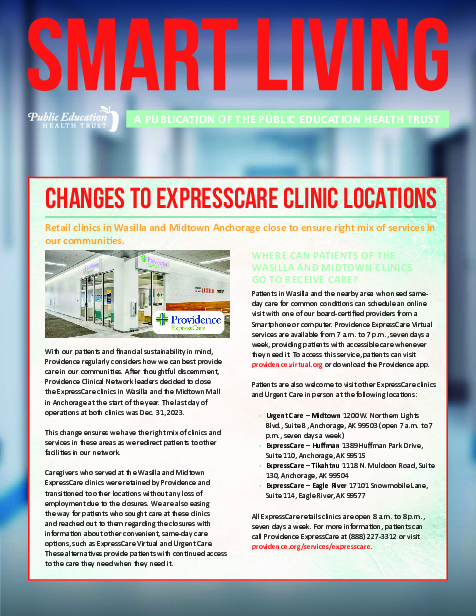Changes to ExpressCare Clinic Locations
Retail clinics in Wasilla and Midtown Anchorage close to ensure right mix of services to our communities.
With our patients and financial sustainability in mind, Providence regularly considers how we can best provide care in our communities. After thoughtful discernment, Providence Clinical Network leaders decided to close the ExpressCare clinics in Wasilla and the Midtown Mallin Anchorage at the start of the year. The last day of operations at both clinics was Dec. 31, 2023.
This change ensures we have the right mix of clinics and services in these areas as we redirect patients to other facilities in our network.
Caregivers who served at the Wasilla and Midtown ExpressCare clinics were retained by Providence and transitioned to other locations without any loss of employment due to the closures. We are also easing the way for patients who sought care at these clinics and reached out to them regarding the closures with information about other convenient, same-day care options, such as ExpressCare Virtual and Urgent Care. These alternatives provide patients with continued access to the care they need when they need it.
WHERE CAN PATIENTS OF THE WASILLA AND MIDTOWN CLINICS GO TO RECEIVE CARE?
Patients in Wasilla and the nearby area who need sameday care for common conditions can schedule an online visit with one of our board-certified providers from a Smartphone or computer. Providence ExpressCare Virtual services are available from 7 a.m. to 7 p.m., seven days a week, providing patients with accessible care whenever they need it. To access this service, patients can visit providence.virtual.org or download the Providence app.
Patients are also welcome to visit other ExpressCare clinics and Urgent Care in person at the following locations:
- Urgent Care – Midtown 1200 W. Northern Lights
Blvd., Suite B, Anchorage, AK 99503 (open 7 a.m. to 7
p.m., seven days a week)
- ExpressCare – Huffman 1389 Huffman Park Drive,
Suite 110, Anchorage, AK 99515
- ExpressCare – Tikahtnu 1118 N. Muldoon Road, Suite
130, Anchorage, AK 99504
- ExpressCare – Eagle River 17101 Snowmobile Lane,
Suite 114, Eagle River, AK 99577
All ExpressCare retails clinics are open 8 a.m. to 8 p.m., seven days a week. For more information, patients can call Providence ExpressCare at (888) 227-3312 or visit
providence.org/services/expresscare.




